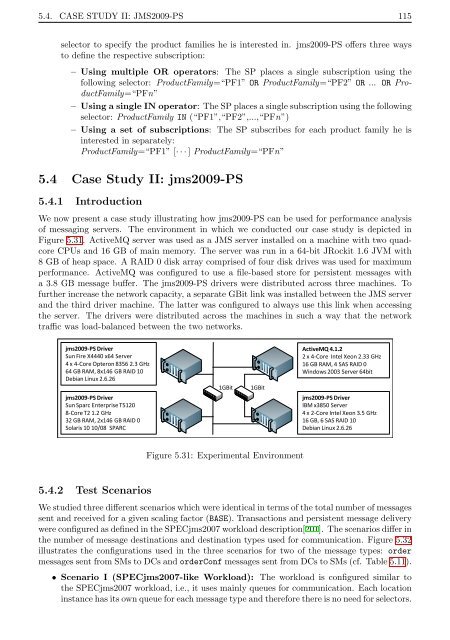Performance Modeling and Benchmarking of Event-Based ... - DVS
Performance Modeling and Benchmarking of Event-Based ... - DVS
Performance Modeling and Benchmarking of Event-Based ... - DVS
Create successful ePaper yourself
Turn your PDF publications into a flip-book with our unique Google optimized e-Paper software.
5.4. CASE STUDY II: JMS2009-PS 115<br />
selector to specify the product families he is interested in. jms2009-PS <strong>of</strong>fers three ways<br />
to define the respective subscription:<br />
– Using multiple OR operators: The SP places a single subscription using the<br />
following selector: ProductFamily=“PF1” OR ProductFamily=“PF2” OR ... OR ProductFamily=“PFn”<br />
– Using a single IN operator: The SP places a single subscription using the following<br />
selector: ProductFamily IN (“PF1”,“PF2”,...,“PFn”)<br />
– Using a set <strong>of</strong> subscriptions: The SP subscribes for each product family he is<br />
interested in separately:<br />
ProductFamily=“PF1” [· · · ] ProductFamily=“PFn”<br />
5.4 Case Study II: jms2009-PS<br />
5.4.1 Introduction<br />
We now present a case study illustrating how jms2009-PS can be used for performance analysis<br />
<strong>of</strong> messaging servers. The environment in which we conducted our case study is depicted in<br />
Figure 5.31. ActiveMQ server was used as a JMS server installed on a machine with two quadcore<br />
CPUs <strong>and</strong> 16 GB <strong>of</strong> main memory. The server was run in a 64-bit JRockit 1.6 JVM with<br />
8 GB <strong>of</strong> heap space. A RAID 0 disk array comprised <strong>of</strong> four disk drives was used for maximum<br />
performance. ActiveMQ was configured to use a file-based store for persistent messages with<br />
a 3.8 GB message buffer. The jms2009-PS drivers were distributed across three machines. To<br />
further increase the network capacity, a separate GBit link was installed between the JMS server<br />
<strong>and</strong> the third driver machine. The latter was configured to always use this link when accessing<br />
the server. The drivers were distributed across the machines in such a way that the network<br />
traffic was load-balanced between the two networks.<br />
jms2009-PS Driver<br />
Sun Fire X4440 x64 Server<br />
4 x 4-Core Opteron 8356 2.3 GHz<br />
64 GB RAM, 8x146 GB RAID 10<br />
Debian Linux 2.6.26<br />
jms2009-PS Driver<br />
Sun Sparc Enterprise T5120<br />
8-Core T2 1.2 GHz<br />
32 GB RAM, 2x146 GB RAID 0<br />
Solaris 10 10/08 SPARC<br />
1GBit<br />
1GBit<br />
ActiveMQ 4.1.2<br />
2 x 4-Core Intel Xeon 2.33 GHz<br />
16 GB RAM, 4 SAS RAID 0<br />
Windows 2003 Server 64bit<br />
jms2009-PS Driver<br />
IBM x3850 Server<br />
4 x 2-Core Intel Xeon 3.5 GHz<br />
16 GB, 6 SAS RAID 10<br />
Debian Linux 2.6.26<br />
Figure 5.31: Experimental Environment<br />
5.4.2 Test Scenarios<br />
We studied three different scenarios which were identical in terms <strong>of</strong> the total number <strong>of</strong> messages<br />
sent <strong>and</strong> received for a given scaling factor (BASE). Transactions <strong>and</strong> persistent message delivery<br />
were configured as defined in the SPECjms2007 workload description[201]. The scenarios differ in<br />
the number <strong>of</strong> message destinations <strong>and</strong> destination types used for communication. Figure 5.32<br />
illustrates the configurations used in the three scenarios for two <strong>of</strong> the message types: order<br />
messages sent from SMs to DCs <strong>and</strong> orderConf messages sent from DCs to SMs (cf. Table 5.11).<br />
• Scenario I (SPECjms2007-like Workload): The workload is configured similar to<br />
the SPECjms2007 workload, i.e., it uses mainly queues for communication. Each location<br />
instance has its own queue for each message type <strong>and</strong> therefore there is no need for selectors.















